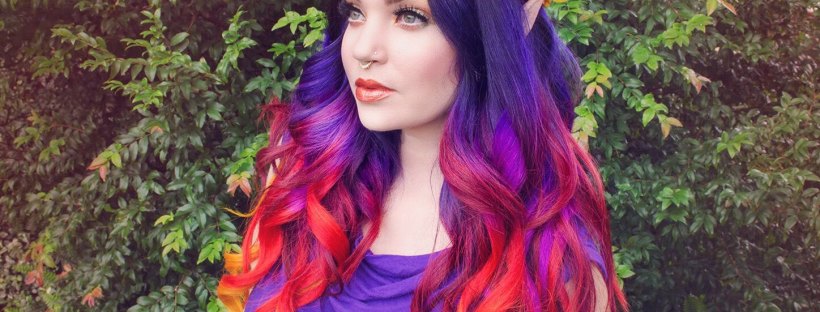Some time ago I’ve started research about fibers I could use as a dolly hair and dye on my own at home.
There were lots of different fibers used for doll hair over different time periods – from twine, yarn, animal fur, plant fibers to modern day artificial fibers like viscose, nylon, saran, or kanekalon.
[if you’ll be interested in my rewiev on different hair fiber types – let me know!]
When it comes to a project with specific color of hair needed there are two options, both time and money consuming:
– you can try to find needed color on market, and buy it just for this one project, not knowing if it will be used anytime again
– or you can dye some fiber by yourself, but then there are only several fibers that can be dyed at home, and these are not cheap either…
So you can encounter an order with non-existing hair color, that cannot be found in any store or do not match your needs in case of length, color mixing [e.g. ombre hair] or texture.
[one of my Client’s wanted this exact hairstyle for his Fashion Royalty doll – and I delivered!]

If you want to dye a fiber – most of the time you’re limited to animal fur fibers.
I am okay with using animal fur as long as it was a fair-trade item, that was picked with no harm for animal
– but there are not much too choose from if I want all above aspects taken into consideration!
Also – process is time consuming, and with artificial fibers like saran or brushed acrylic yarn the problem is that you cannot dye them on your own
I was thinking: okay, but most of retro dolls I owned had viscose hair… and viscose is basically a natural thread made from wood pulp and it can be dyed – so there have to be some other plant fibers I could use as doll hair!
And that’s how I came across plant fibers meant to be used for spinning.
[yes, there are plant fiber yarns, not only woolen or acrylic ones 🙂 ]
What is this spinning fiber stuff anyways?!
– spinning fiber is lightly twisted hank of plant fibers, often bleached during production process.
These can be dyed with normal textile dyes, and do not require hot process acid dye as animal fibers.
Length of wefts you’ll get depends on what plant you’ll choose, but there can be 10 cm / 4 inches wefts and even 25 cm/10 inches wefts
– something you’ll never achieve with my favorite brushed acrylic yarn! [brushed acrylic yarn is usually between 3 and 4,2 inches long, depending on used brand and twist]
Thanks to SpinFlora shop on Etsy I was able to order several samples and check how these will behave when dyed, curled, and brushed.
In my sample I got 25 grams of each:
– Banana
– Bamboo
– Tencel /a wood celulose fiber
– Mint
– Ramie / Nettle
There are very accurate descriptions on how each fiber is harvested on SpinFlora’s listings – so if you’re interested in these – visit Paivi’s store.
Here are all the fibers before dyeing process, brushed and made into small wefts accurate for doll wigs:

As you can see – there are some differences in length color and texture of the fibers – I will explain them one by one.
TENCEL / VISCOSE
Tencel is also known as Lyocell or rayon. Tencel is the early viscose type of fibres, invented in the 1970’s and it’s a wood cellulose fiber.
After brushing off all excess and loose fibers, trimming one end and glueing you can get a 8 -12 cm weft. Nice result, similar to what you can get with acrylic yarns, but this one you can dye yourself.

After dyeing and brushing it again – that’s the result:
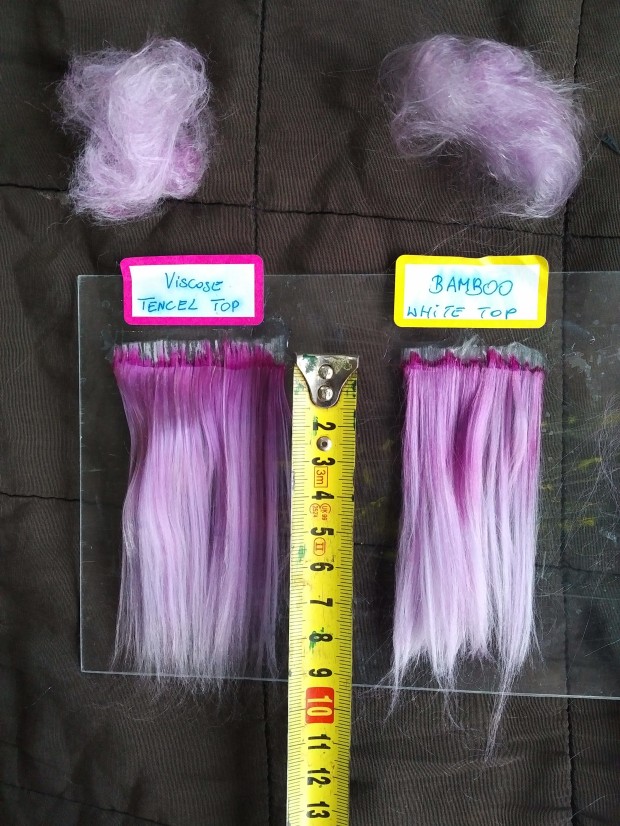
As you can see – you’ll loose around 1-2 cm length after dyeing, and second brushing.
Viscose gets color from dye just great – it will result in vibrant and lustrous look even after just a short bath!
There are lots of remnants after first brushing.
This fiber is very soft, lightweight and puffy when used as doll hair, but looks natural and is easy to tame.
BAMBOO
Bamboo viscose top is one of the relatively new handspinning fibres. The bamboo is processed into a cellulose pulp and wet spun into silky filaments. It is super-soft to touch, but also very puffy and hard to tame, since you cannot use anything wet on it.
It also lose a lot of volume during first brushing.Like… probably 50% of fiber you’ve started with will be brushed off!
After brushing off excess and loose fiber – you can get wefts of 12-15 cm length. [you can see it above side to side with viscose weft]
Sounds impressive, but don’t be overly enthusiastic about it – here is again [upper photo] result after dye bath and second brushing – same 8 -11 cm weft as with viscose fiber!
– so you lost almost 5cm length during second process.
Bamboo will loose a lot of it’s length and volume during process. It is fiber with the biggest remnant from all I’ve tested and the most sensitive to moisture.
I am also moderately happy about how it works as a doll hair material – in my opinion this fiber is too delicate and creates so much static electricity when brushed it is hard to tame.
Here is the effect of a doll wig made with bamboo fiber:
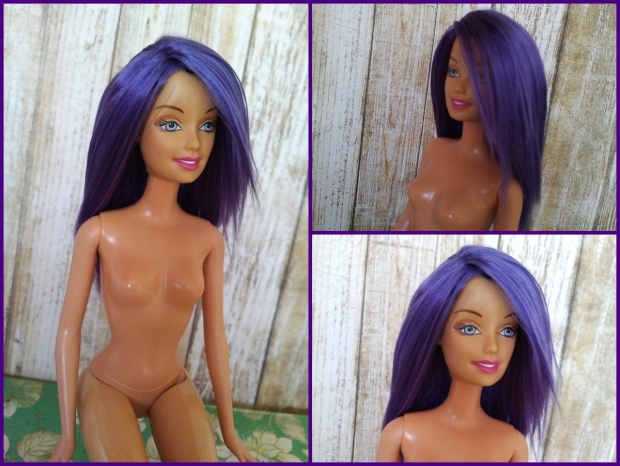 It looks great, but there was a lot of swearing during the process of taming this hairstyle 😛
It looks great, but there was a lot of swearing during the process of taming this hairstyle 😛
BANANA
This one is known from XIII century in Asia! And my absolutely favorite plant fiber from all the samples ❤
Banana is a strong fiber with a shiny appearance. It is also light weight fiber with high moisture absorption as well as quick moisture release – so when you’ll dye it – it will dry a lot quicker than others. Usually after a few hours it will be ready to go, when other fibers needed at least whole night.
Banana fiber will give you impressive 20 – 22 cm long wefts!
Pure white, pearly and soft – just divine doll hair!
This is banana fiber after first brushing :

And here is banana fiber after dye batch and second brushing:
– not much of loose fibers in this case
– still great length – 20 cm! It was first natural fiber with such a great length I found.
I am hyped about this one. ❤
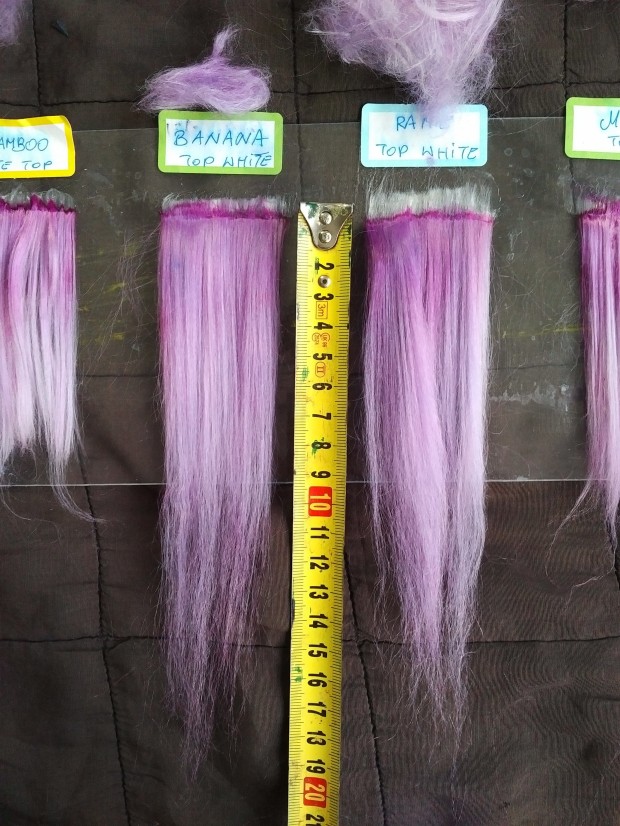
Banana fiber will sip dye like crazy, so you must be careful when making ombre or want a pastel look – avoid dipping these wefts for too long or too deep in dye bath or they will drown in it.
There were only 2 cm length lost during second brushing, so finished wefts are still around mid-calf for most of Mattel dolls. Great result!
Soft, yet sturdy hair with great length and easily taking color from dye – p e r f e c t i o n.
RAMIE
Ramie comes from a plant of the nettle family. It is one of the oldest known fibers. Ramie was used as mummy bandages in Egypt and has been grown in China for many centuries.
Ramie has a silky luster and is pure white in colour.
There will be lots of loose fibers in both first and second brushing, but the fiber is sturdy and will loose no more than 1-2 cm length during the process.
It can be dyed easily, but result is more pastel than with other fibers. It also sometimes changes color a bit. When I dyed it to pink – some of strands were more into violets than pinks, even tho I was using the same dye bath all the time.
Overall – really good choice! It is as good as Banana – it’s just my personal preference that finds Banana fiber just a bit more tempting to use.
MINT
The colour of this roving is a light shade of latte / ivory.
It is very thin and soft, but sturdy fiber.

It will not loose too much of volume or length during first brushing, nor in the dye bath.
One thing you must remember when using it – any color you’ll dye it will result in darker and more warm shade than original bath was.
But it can be used as natural flax blonde hair without any dye – it is great! 🙂
Here is the result after dye bath and second brushing:
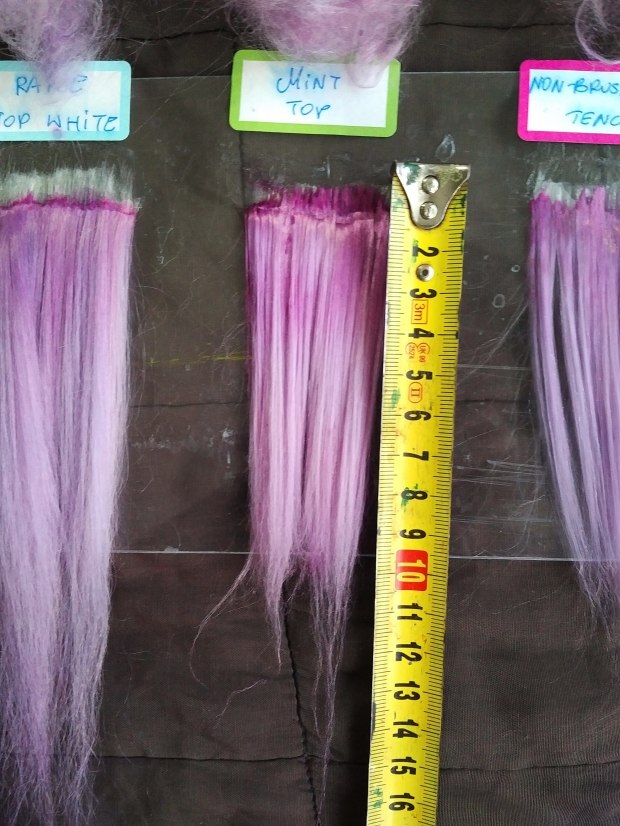 – less than 1cm lost in length! great result, especially for such delicate to touch fiber!
– less than 1cm lost in length! great result, especially for such delicate to touch fiber!
Some thoughts, F.A.Qs and don’t-do’s about plant spinning fibers:
- I used both textile dye and wool dye [acid dye] – both worked really well.
I made them with almost boiling water, and leaved for a while to cool down to the point when it is still warm, but do not burn your hands. - You can make wefts in two ways:
– by making white wefts and dyeing them as you’d do with human hair – by using a paintbrush and painting strokes on them. This is the messy way.
– by brushing off excess fiber, making small hanks of brushed fiber and diping them into a dye bath, then leave to fully dry. This is the long shot – since hanks will dry longer than wefts.
But it will give more natural look and color depth. - When you dye plant fibers they tend to stick to each other and you need to leave them till fully dry!
Wet or even slightly damp plant fibers are too delicate to brush them and can be easily damaged!!!
You can curl plant fibers same as you would do with brushed acrylic yarn – by using hair straightener and a chopstick.
– Bamboo and banana will take and hold curls best of all fibers.
– Viscose and mint will give you loose locks / waves.
– Ramie do not even need chopstick procedure – when you put it between hot plates of a straightener and pull [I use mine with high temp. around 140 °C when working with yarn and plant fibers] it will slightly twist itself into sweet spiral locks.
RAMIE WILL NOT CURL UNDER BLOW DRYER- – you need to pull it with hair iron.
Here are some curls on wefts I made for this experiment:
I used white glue / PVA glue to make wefts. After fully dry it survived dyeing wefts with paintbrush. I would not recommend dipping it tho!
Dyes you can use for the process
- You can use any textile dye: RIT, Procion, or whatever you have on hand, but saturation of color will be different for every dye . It also depends on how long you dip fibers in dye bath.
Procion dye – is it so much better or what?
I checked – Procion dye is exact same dye I can get in small bags in my local stores as a no-name brand… the ones you need to add salt to dye bath before use [you can check it in description on the box].
In Procion products salt is already added. You pay for brand.
All dyes with salt needed to activate color are called cation reactive dyes as I could found out by googling all over the web 😀
– and they work better on viscose since the fiber is made by using strong acids during production, what makes it sensitive to alkalines.
You can use Procion, or you can use any no name brand of dye meant to be used on clothes. Simple as that.
Just remember not to use too hot water!
And here is the wig I made with my fav Banana Fiber – isn’t it just stunning?
This is literally THE LONGEST POST I EVER MADE – if you are here – give yourself a pat in the back for your hunger of knowledge and impressive patience 😉
Enjoy expertimenting with newly gathered infos!

